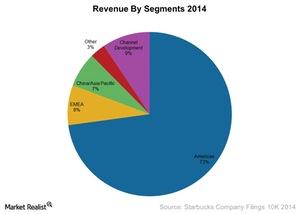Why The Americas Segment Is Important For Starbucks
The America’s segment includes revenues mainly from the US, Mexico, and Canada. This segment accounted for 73% of SBUX’s revenues in 2014.
Dec. 26 2014, Updated 2:40 p.m. ET

Revenue by segments
In the last part of this series, we learned about the revenue contribution from the Starbucks Corporation’s (SBUX) three revenue sources. The following chart shows SBUX’s revenue by segment.
The Americas
The America’s segment includes revenues mainly from the US, Mexico, and Canada. This segment accounted for 73% of SBUX’s revenues in 2014. As the other markets gain traction, the contribution from this segment has been on a declining trend. It was 77.5% in 2011. The US had the most stores in this segment. It had 11,962 stores.
China and Asia-Pacific
This segment mainly includes revenues from China, Japan, South Korea, Taiwan, and the Philippines. This segment’s revenue contribution increased from 4.7% in 2011 to 6.9% in 2014. In this segment, 1,367 stores are located in Japan.
This region is becoming more important for several restaurant players—like Kentucky Fried Chicken, or KFC, Pizza Hut, and Taco Bell under the umbrella of Yum! Brands (YUM). It’s also becoming more important for McDonald’s (MCD).
Some of the restaurants mentioned above are also included in the SPDR S&P 500 ETF (SPY).
EMEA
The EMEA (Europe, Middle East and Africa) segment mainly includes revenues from the United Kingdom, Turkey, the United Arab Emirates, Spain, Kuwait, Saudi Arabia, and Russia. The revenue contribution from this segment declined from 8.9% in 2011 to 7.9% in 2014. In this segment, 791 stores are located in the United Kingdom.
Other
The Other segment includes revenues from Teavana and Seattle’s Best Coffee stores. The stores sell tea and coffee products. This segment accounted for 3% of SBUX’s revenues in 2014.
Channel Development
SBUX’s coffees are sold through grocery stores, specialty retailers, warehouse clubs, convenience stores, and US Foodservice accounts—like Costco (COST) and Walmart (WMT). This segment accounted for 9% of SBUX’s revenues in 2014.
It’s important for an investor to know certain indicators that drive SBUX’s revenues. The indicator’s health will give you a better understanding of your investment in SBUX. Continue reading the next part of this series to learn more.
